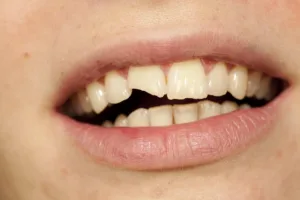
A fractured or cracked tooth occurs due to age, tooth grinding, trauma and other factors. You might not have any symptoms of a fractured tooth. Or you might notice pain, sensitivity and swelling. Your dentist has several methods to treat a broken tooth, depending on the crack’s location and severity.
What is a fractured tooth?
A fractured tooth, often called a broken tooth is when a crack appears in your tooth. The crack can sometimes be small and harmless. Other times, it can cause your tooth to break or split.
Tooth fractures are most common in children and older people, although anybody can crack a tooth. If you suspect a broken tooth, see a dentist right away.
What parts of a tooth can crack?
Teeth consist of two parts:
- The crown is visible above your gums.
- The root lies below your gums.
Both the crown and the root consist of several layers:
- Enamel: Hard white outer surface.
- Dentin: Middle layer of the tooth.
- Pulp: Soft inner tissue that contains blood vessels and nerves.
Tooth fractures can affect some or all of these layers. Treatment for a cracked tooth depends on where the fracture happens and the severity of the fracture.
A broken tooth may hurt or feel sensitive, though some fractures cause no symptoms. See a dentist right away. Getting treatment sooner increases the chances of repairing a cracked tooth.
What causes a broken tooth?
The most common causes of tooth fractures are:
- Age, with many tooth cracks happening at age 50 and older.
- Biting hard foods, such as candy, ice or popcorn kernels.
- Habits, such as gum chewing, ice chewing.
- Large dental fillings or a root canal, which weaken the tooth.
- Teeth grinding (bruxism).
- Trauma, including falls, sports injuries, bike accidents, car accidents or physical violence.
Which teeth are most likely to fracture?
Fractures occur most often on the upper front teeth and the teeth toward the back of your lower jaw (mandibular molars). Though people commonly fracture one tooth, more severe injury or trauma may fracture multiple teeth. People with dental cavities have a higher risk of fracture, even with less severe trauma.
What are the symptoms of cracked tooth syndrome?
Cracked teeth don’t always cause symptoms. When they do, the main symptoms include:
- Pain that comes and goes, particularly when chewing.
- Sensitivity to temperature changes or eating sweet foods.
- Swelling around the tooth.
- Toothache when biting or chewing.
How do healthcare providers diagnose broken teeth?
To diagnose a fractured tooth, your dentist will ask about your symptoms and what caused the possible broken tooth. They will ask about trauma or injury you’ve experienced.
For a thorough evaluation of your teeth, you’ll need to see a dentist. They will ask about your dental history and whether you grind your teeth or chew on ice or hard foods.
After that, your dentist will:
- Check to see whether your tooth is broken or knocked out (avulsed tooth).
- Ask you to bite down on a stick to see if you feel pain.
- Inspect your teeth for crack lines.
- Examine your gums for inflammation, since vertical fractures may irritate your gums.
- Pass a light through your tooth to illuminate the fracture (transillumination).
- Put a staining dye on your tooth to better see the tooth crack.
- Take an X-ray of your teeth to see fractures and related issues, such as bone loss.
- Use special tools to locate the crack (periodontal probing) by checking if the tools get caught on the crack.
What are the types of tooth fracture?
Your dentist will classify your fracture as one of the following five categories:
- Cracked tooth: A vertical crack runs from the biting surface of your tooth up to your gum line. Sometimes the crack extends into your gum line and root.
- Craze lines (hairline cracks): Small, thin cracks appear on the outer enamel of your tooth. Craze lines don’t cause any pain.
- Fractured cusp: A crack forms around a dental filling. Fractured cusps usually aren’t very painful.
- Split tooth: A crack extends from your tooth’s surface to below your gum line. This fracture splits your tooth into two parts.
- Vertical root fracture: Cracks start below your gum line and travel toward the tooth’s biting surface. Vertical root fractures may not cause symptoms unless your tooth becomes infected.
Can I treat a broken tooth at home?
- Place an ice pack on the outside of your mouth to prevent swelling.
- Rinse your mouth with salt water to clean your teeth.
How do dentists treat a fractured tooth?
Treatment for a fractured tooth depends on how much damage your tooth has. Common cracked tooth treatments include:
- Bonding/tooth coloured filling: Plastic resin is used to fill in the fracture.
- Cosmetic contouring: Rough edge rounding and polishing smooths out the broken tooth.
- Crown: A porcelain or ceramic cap is fitted over the fractured tooth. Often used when you don’t have enough of your natural tooth for a veneer.
- Extraction: Complete removal of your tooth. Used when the root and nerves of your tooth show severe damage.
- Root canal: Removal of damaged pulp to prevent further tooth weakening. Used when the fracture extends into the pulp.
- Veneer: A thin covering of porcelain or plastic goes over the front of the tooth. Often used when you have a good amount of your natural tooth left.
Sometimes your dental provider may recommend not repairing a broken tooth at all. This may occur when your fracture does not:
- Affect your appearance.
- Cause pain.
- Extend very deep or far, such as a hairline crack.
Can I prevent a broken tooth?
You can’t prevent every tooth fracture. But you can reduce the risk of cracked tooth syndrome with good dental practices:
- Avoid chewing hard foods or ice.
- Practice good teeth and gum care.
- Wear a mouth guard made by your dentist if you play sports or grind your teeth at night.
- See your dentist regularly.
Can a cracked tooth heal?
No, a cracked tooth can’t heal, but treatment might save your tooth. Getting your broken tooth repaired quickly can lessen your risk of more damage and infection.
How long will my broken tooth repair take?
Repairing your broken tooth may take weeks or months depending on your treatment. Your dentist will give you a better idea of how long your specific repair might take. For instance:
- Crowns: Your dentist can sometimes fit a crown in a day, but it often takes multiple appointments.
- Extractions: Replacing the tooth with a dental implant can take months.
- Veneers: It usually takes three to four weeks to create a veneer before a dentist can fit it to your tooth.
